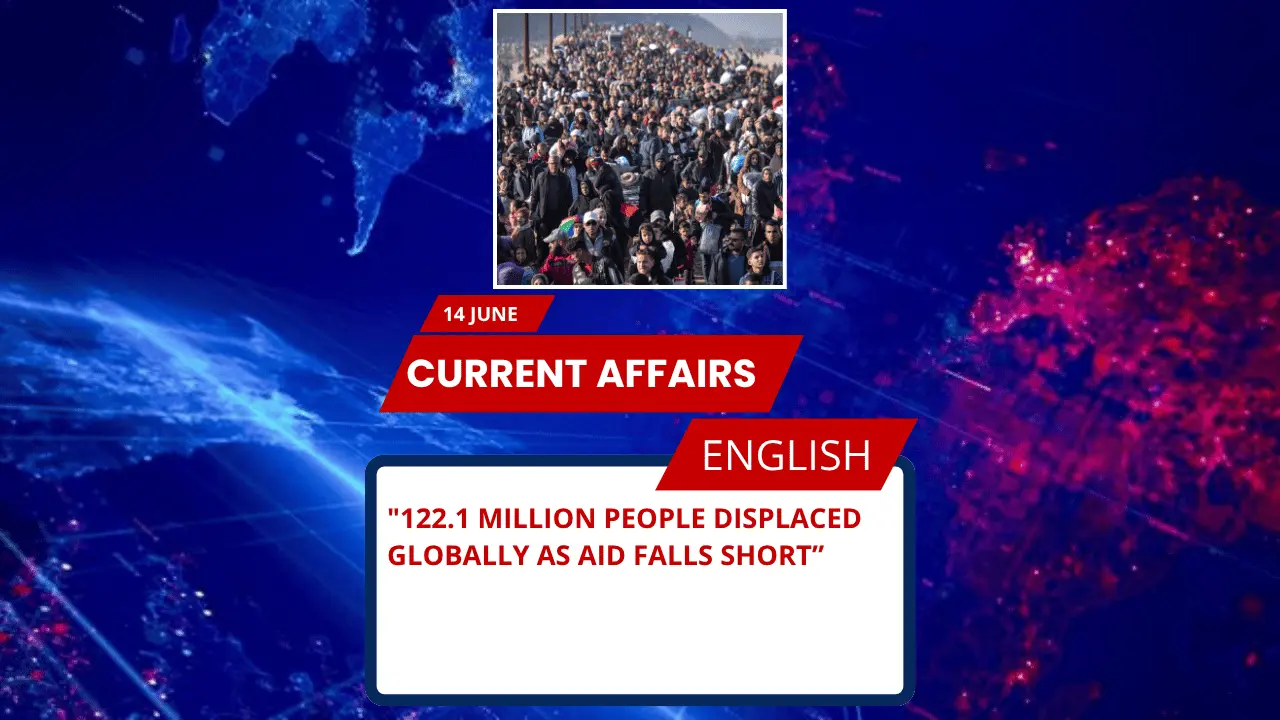
Key Points for SSC, UPSC, and Other Government Exams
- Global displaced population: 122.1 million (April 2025)
- Internally displaced persons (IDPs): 73.5 million
- Top displacement drivers: Sudan (14.3 million), Syria (13.5 million), Afghanistan (10.3 million), Ukraine (8.8 million)
- Major refugee hosting countries: Iran (3.5 million), Turkey (2.9 million), Colombia (2.8 million), Germany (2.7 million), Uganda (1.8 million)
- 2024 returns: 9.8 million (including 2 million Syrians)
- UNHCR funding crisis: Severe shortfall as nations reduce aid
A Deep Dive into the Global Displacement Crisis
Alarming Rise in Global Displacement
As of April 2025, the United Nations High Commissioner for Refugees (UNHCR) reports 122.1 million people forcibly displaced worldwide. Although slightly down from the 2024 peak of 123.2 million, the situation remains critical, demanding global action.
Conflict Hotspots Driving Displacement
Sudan Leads in Displacement
- Sudan: 14.3 million displaced (overtakes Syria)
- Syria: 13.5 million displaced
- Afghanistan: 10.3 million displaced
- Ukraine: 8.8 million displaced
These nations are the major sources of displacement, driven by wars, internal conflicts, and instability.
The Internally Displaced Majority
By end of 2024:
- IDPs: 73.5 million (60% of all displaced)
- Most IDPs do not cross borders, staying within their conflict-ridden nations.
Refugees Hosted Mostly by Low & Middle-Income Countries
Contrary to popular belief, wealthy nations are not the largest refugee hosts.
Top hosting countries:
- Iran: 3.5 million refugees
- Turkey: 2.9 million refugees
- Colombia: 2.8 million refugees
- Germany: 2.7 million refugees
- Uganda: 1.8 million refugees
This reveals the burden on developing nations.
Return Migration Trends
Positive signs emerged in 2024:
- 2 million Syrians returned in 6 months.
- 9.8 million displaced people returned to their regions (refugees + IDPs).
UNHCR’s Funding Struggles
The UNHCR faces funding gaps as many nations have cut their contributions. The agency stresses the urgent need for renewed global support to ensure stability.
Important Facts About Mentioned Organizations
United Nations High Commissioner for Refugees (UNHCR)
- Established: 1950
- Headquarters: Geneva, Switzerland
- Mandate: Protect and support refugees, forcibly displaced communities, and stateless people
- Current High Commissioner: Filippo Grandi
Possible MCQs for SSC/UPSC
1. As of April 2025, how many people are globally displaced as per UNHCR?
A) 123.2 million
B) 122.1 million
C) 121.5 million
D) 120 million
Answer: B) 122.1 million
2. Which country has the highest number of displaced people in 2025?
A) Syria
B) Afghanistan
C) Sudan
D) Ukraine
Answer: C) Sudan
3. Which country hosts the largest refugee population as of April 2025?
A) Germany
B) Iran
C) Uganda
D) Colombia
Answer: B) Iran
4. Where is UNHCR headquartered?
A) New York
B) Paris
C) Geneva
D) London
Answer: C) Geneva
5. What percentage of forcibly displaced people are internally displaced?
A) 50%
B) 60%
C) 70%
D) 80%
Answer: B) 60%
UPSC Style FAQs (Answer Writing Format)
Q1. Discuss the key drivers and trends in global displacement as reported in 2025.
Answer:
The global displacement crisis, as reported by UNHCR in April 2025, highlights an alarming figure of 122.1 million forcibly displaced people. The primary drivers of this displacement are armed conflicts and political instability. Notably, Sudan has emerged as the top contributor, surpassing Syria, with 14.3 million displaced persons. Other significant contributors include Syria (13.5 million), Afghanistan (10.3 million), and Ukraine (8.8 million).
A striking trend is that 60% of these displaced populations are internally displaced persons (IDPs), who remain within their countries. Additionally, low and middle-income nations such as Iran, Turkey, and Colombia host the bulk of refugees, challenging the notion that richer countries bear the larger refugee burden.
Despite ongoing conflicts, there are signs of return migration, with 2 million Syrians and a total of 9.8 million displaced individuals returning home in 2024. The crisis is compounded by a severe funding shortfall for UNHCR, jeopardizing essential humanitarian interventions.
Q2. Evaluate the role of low and middle-income countries in hosting refugees and its implications for global stability.
Answer:
Low and middle-income countries play a critical role in providing asylum to refugees, as evidenced by 2025 data where Iran (3.5 million), Turkey (2.9 million), and Colombia (2.8 million) top the list of host nations. This disproves the perception that high-income nations carry the primary burden of hosting displaced populations.
The disproportionate hosting by resource-constrained countries places immense strain on their social, economic, and infrastructural systems, potentially leading to regional instability. The lack of adequate support from wealthier nations and the ongoing funding shortfall for UNHCR exacerbate these challenges.
For sustainable global stability, a balanced responsibility-sharing mechanism is essential. This includes enhanced financial and technical support to host nations and stronger international cooperation for conflict resolution in source countries.







